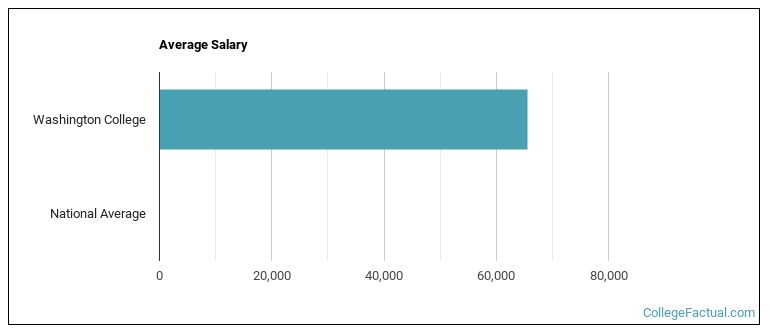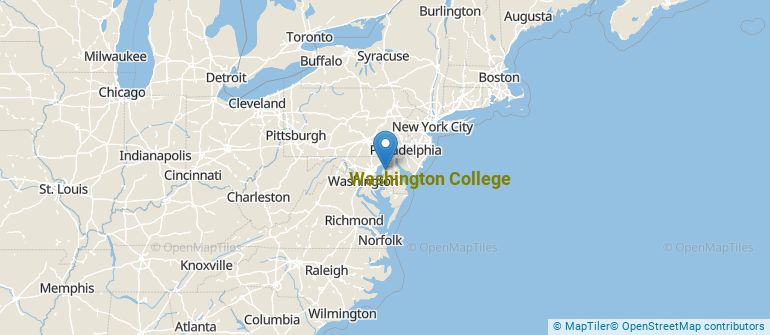 by our College Data Analytics Team
by our College Data Analytics TeamExplore the best ranked schools for the programs you are most interested in.
According to College Factual's 2025 analysis, Washington College is ranked #745 out of 2,152 schools in the nation that were analyzed for overall quality. This is an improvement over the previous year, when Washington College held the #776 spot on the Best Overall Colleges list.
When it comes to admittance, Washington College is somewhat selective. Its acceptance rate is 75%, which means you'll face some strong competition during the admissions process. Do what you can to make your application stand out.
About 29% of students accepted to Washington College submitted their SAT scores. When looking at the 25th through the 75th percentile, SAT Evidence-Based Reading and Writing scores ranged between 620 and 710. Math scores were between 570 and 680.
The student to faculty ratio at Washington College is an impressive 9 to 1. That's quite good when you compare it to the national average of 15 to 1. This is a good sign that students at the school will have more opportunities for one-on-one interactions with their professors.
Another measure that is often used to estimate how much access students will have to their professors is how many faculty members are full-time. The idea here is that part-time faculty tend to spend less time on campus, so they may not be as available to students as full-timers.
The full-time faculty percentage at Washington College is 86%. This is higher than the national average of 47%.
Washington College has a freshmen retention rate of 83%. That's a good sign that full-time students like the school and their professors enough to want to stick around for another year. It's also a sign that the admissions team did a good job in choosing applicants who were a good fit for the school.
The on-time graduation rate for someone pursuing a bachelor's degree is typically four years. This rate at Washington College for first-time, full-time students is 69%, which is better than the national average of 33.3%.
Find out more about the retention and graduation rates at Washington College.
During the 2017-2018 academic year, there were 1,089 undergraduates at Washington College with 1,075 being full-time and 14 being part-time.
| $0-30 K | $30K-48K | $48-75 | $75-110K | $110K + |
|---|---|---|---|---|
| $20,047 | $26,719 | $17,320 | $12,004 | $5,898 |
The net price is calculated by adding tuition, room, board and other costs and subtracting financial aid.Note that the net price is typically less than the published for a school. For more information on the sticker price of Washington College, see our tuition and fees and room and board pages.
It's not uncommon for college students to take out loans to pay for school. In fact, almost 66% of students nationwide depend at least partially on loans. At Washington College, approximately 49% of students took out student loans averaging $7,659 a year. That adds up to $30,636 over four years for those students.

Get more details about the location of Washington College.

Contact details for Washington College are given below.
| Contact Details | |
|---|---|
| Address: | 300 Washington Ave, Chestertown, MD 21620-1438 |
| Phone: | 410-778-7700 |
| Website: | www.washcoll.edu/ |
| Most Popular Majors | Bachelor’s Degrees | Average Salary of Graduates |
|---|---|---|
| Business Administration & Management | 50 | NA |
| General Psychology | 34 | $34,490 |
| General Biology | 26 | $34,553 |
| Natural Resources Conservation | 20 | $22,324 |
| Political Science & Government | 20 | $36,741 |
| Economics | 19 | $50,835 |
| General English Literature | 18 | NA |
| History | 12 | NA |
| Computer Science | 11 | NA |
| Sociology | 9 | NA |
If you’re considering Washington College, here are some more schools you may be interested in knowing more about.
Curious on how these schools stack up against Washington College? Pit them head to head with College Combat, our free interactive tool that lets you compare college on the features that matter most to you!
Footnotes
*The racial-ethnic minorities count is calculated by taking the total number of students and subtracting white students, international students, and students whose race/ethnicity was unknown. This number is then divided by the total number of students at the school to obtain the racial-ethnic minorities percentage.
References
More about our data sources and methodologies.